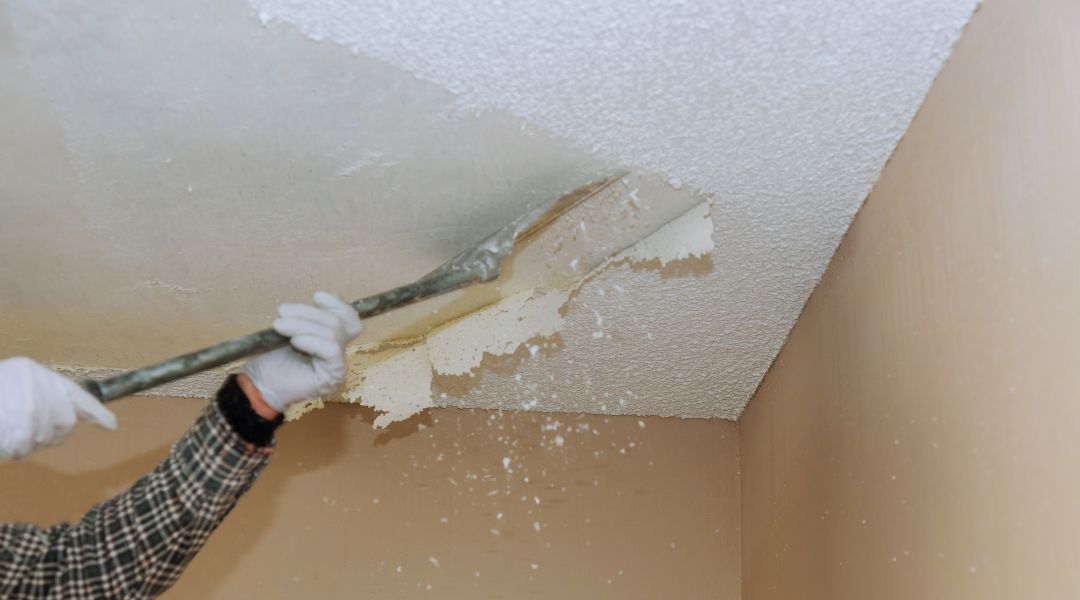Asbestos Popcorn Ceiling Removal

Common Types of Asbestos:
Chrysotile. This is white asbestos mined in the US, Canada, China, and Russia. It is the most common type of asbestos found worldwide. It is the fibrous form of the mineral serpentine. Ninety-five percent of ACBM (Asbestos Containing Building Materials) is chrysotile and is used in cement building materials.
Amosite. This is brown asbestos from South Africa. It is used for cement sheets and high-temperature pipe insulation.
How Common is Asbestos in Popcorn Ceilings?
A popcorn ceiling usually has a pockmarked surface and is typically white, off-white, or beige.
The Environmental Protection Agency (EPA) banned asbestos from ceiling coverings in 1973. However, researchers noted that popcorn ceiling materials still had asbestos even after the ban.
What to Do If Your Popcorn Ceiling Has Asbestos?
Homeowners who think that their popcorn ceilings have asbestos should hire professionals to test, remove, and dispose of it. Asbestos abatement and removal contractors like CVE Corp should be the only ones handling asbestos. Sanding, painting, or patching popcorn ceilings could disturb its fibers and create dangerous asbestos dust.
Asbestos removal involves carefully ridding the home of asbestos products. A licensed professional will safely and legally dispose of the asbestos. Asbestos encapsulation covers up the asbestos-containing products to prevent fibers from being released into the air.
Our professionals are trained in state and federal regulations for the proper handling of asbestos. We will conduct a thorough inspection of any material that may have asbestos. We will inspect for damage, take a sample of the ceiling and suspected materials, and send them for laboratory testing. If asbestos is positive, a mitigation and removal plan will be conducted.
A licensed asbestos abatement contractor like CVE Corp will conduct the asbestos removal. We will assess the ceiling’s friability or the crumbliness of the product. Highly friable asbestos is more dangerous since it is more likely to release fibers into the air. Low-friability materials in good condition may be recommended for encapsulation.
For asbestos popcorn ceiling removal, the contractor will shut off ventilation in the whole area. The materials will be wet down to prevent airborne fibers, and the products will then be removed.
Every state has its own regulations for asbestos disposal.
The Dangers of Asbestos in Popcorn Ceilings
Higher-risk groups of people include:
- Construction workers. Occupational exposure happens during construction, renovation, or demolition.
- Homeowners. Asbestos in popcorn ceilings exposes the entire family.
The IARC (International Agency for Research on Cancer) found that inhaling asbestos leads to mesothelioma, and cancers of the lung, larynx, and ovary. It also increases the risk of stomach, pharynx, and other diseases.
What Disturbs Asbestos?
- Nails and hooks. Nails and hooks in the ceiling release asbestos dust.
- Scraping the ceiling. Never kill a bug and scrape it off the ceiling.
- Bunk beds. Kids may kick the ceiling and spread asbestos inadvertently.
How Will CVE Corp Remove Popcorn Ceilings?
Prepare the room. We will put sheets or plastic over furniture that we can’t take out of the room. We will turn off lights, HVAC systems, and any other appliances that won’t let us control the circulation in the room. We will turn off the air conditioning and run a drop cloth over the floor to protect it. All plastic will be secured with painter’s tape to ensure nothing gets under it. No residue should be left.
Spray the ceiling. A sprayer will be filled with warm water and lightly sprayed to a four-foot square area of the ceiling. If the ceiling has textured products without paint, it should absorb the water and be ready for scraping in 15 minutes.
Scrape off the popcorn. A paint scraper or a putty knife will be used to start removing the popcorn from the ceiling. It can be removed while dry or it can be wet with a spray bottle. Wetting the asbestos helps contain it, so it will be a better option.
Let the ceiling dry. A significant amount of drying time is needed. Increasing the temperature and air ventilation will speed up the drying process. Allow the room to dry for 24 hours after removing the ceiling.
Finish up and patch. After the large patches, we will use the putty knife to remove the small pieces. Asbestos will then be disposed of in a plastic bag. We will patch cut loose areas during removal. Imperfections will be taken care of before cleaning up.
Stomp or paint. If there are a lot of imperfections, painting is a better option. The area will be cleaned before painting to ensure no asbestos is left on the wet paint.
Dispose of waste. If the material contains asbestos, we cannot dispose of it with regular landfill waste. We need to obtain a permit and dispose of it separately for up to 30 days.
You can also hire an asbestos remediation professional like CVE Corp to do it for you. The lab should be accredited by NVLAP (National Voluntary Laboratory Accreditation Program).
If the test is positive and the coating is unraveling, you do need to do something. Explore the cost of removal and encapsulation. But an encapsulated coating won’t absorb water easily, so if you or a later owner decides to remove it, the job will be more difficult and expensive.
Removing the popcorn ceiling by doing it yourself can result in tainting your home with asbestos and potentially inhaling and ingesting these fibers. Leave the ceiling alone and call an asbestos abatement contractor to do the work.
If your home has popcorn ceilings, don’t hesitate to reach out to an expert to get a sample and test it to know if it has the presence of asbestos. It’s important to be conscious of the materials used for constructing your home.
About Our Asbestos Abatement Removal Services
With offices in Rohnert Park, Tracy, Fresno, and San Diego and over 30 years of experience in the asbestos removal industry, CVE Corp. is the natural industrial, commercial, and residential environmental solutions across California with 24-hour emergency response available.
• Residential Demolition
• Commercial and Industrial Demolition
• Flooding, Fire, and Restoration Projects
• 24-Hour Emergency Response
• Health, Safety and Environmental Compliance
• Fully Licensed, Bonded and Insured
Contact Us
CVE is the leading expert in Asbestos Abatement and Removal, Demolition Services, Deconstruction Services, Mold Remediation, Lead Abatement, and offer services to San Luis Obispo, San Francisco, Bakersfield, Santa Rosa, Fresno, Sonoma County, Fresno County, East Bay, Visalia, Modesto, Marin County, San Diego County, Napa County, Solano County and beyond.
